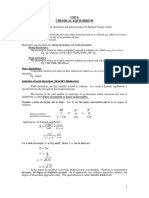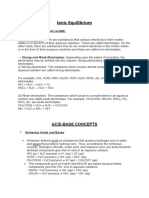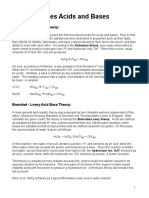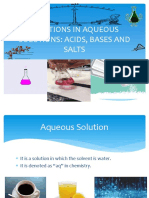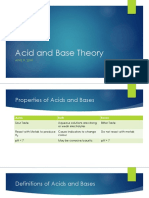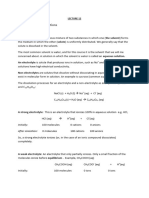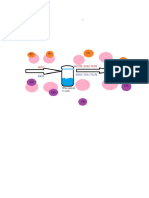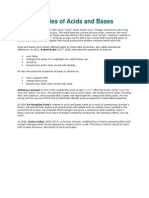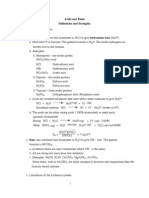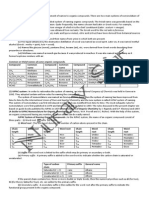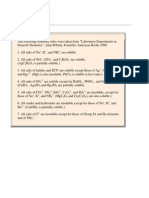Nirav Sir: 2 + - (S) + (Aq) - (Aq)
Nirav Sir: 2 + - (S) + (Aq) - (Aq)
Uploaded by
api-233404189Copyright:
Available Formats
Nirav Sir: 2 + - (S) + (Aq) - (Aq)
Nirav Sir: 2 + - (S) + (Aq) - (Aq)
Uploaded by
api-233404189Original Title
Copyright
Available Formats
Share this document
Did you find this document useful?
Is this content inappropriate?
Copyright:
Available Formats
Nirav Sir: 2 + - (S) + (Aq) - (Aq)
Nirav Sir: 2 + - (S) + (Aq) - (Aq)
Uploaded by
api-233404189Copyright:
Available Formats
Nirav Sir Page 1
CHAPTER 4 IONIC EQUILIBRIUM
Electrolyte:
Compounds which dissociate into ions, when dissolved in water are called electrolytes. Aqueous
solution of electrolyte show electrical conductivity.
Strong electrolytes:
The electrolyte which dissociate completely into its ions on dissolution in water are called strong
electrolyte. Their aqueous solutions are good conductor of electricity. They are ionic compounds
like NaNO3, NaCl, CaCl2 etc.
Weak electrolytes:
These electrolytes are either ionic or polar co-valent compounds. The electrolyte which dissociate
partially into its ions on dissolution in water . Aqueous solutions of weak electrolytes are poor
conductor of electricity.CH3COOH, NH3 etc are weak electrolytes.
Ionic solids:{additional}
Compounds having ions as their constituents in solid state are known as ionic solids ionic solids
when dissolved in water, do not form ions but the ions which are held firmly in their lattice
positions are set free and conduct electricity. e. g. NaCl
H
2
O
Na
+
Cl
(s)
Na
+
(aq)
+ Cl
(aq)
Degree of ionisation:
The fraction of dissolved compounds ionized is known as the degree of ionization. Degree of
ionization increases with rise in temperature as ionization process is endothermic reaction.
Ionic equilibrium:
In case of aqueous solution of electrolytes, when the rate of ionization by interaction of solute
with water ( solvent) becomes equal to the rate of recombination of positive and negative ions, an
equilibrium is established which is called ionic equilibrium at constant temperature.
Self ionisation of water.
Dissociation of water forms
( )
and
( )
ions in small concentrations as water is a weak
electrolyte. This phenomenon is known as self ionisation of' water.
Explain degree of ionization. :{ additional}
Fraction of substance ionized out of the total dissolved quantity of substance is called degree of
ionization.
When degree of ionisation is multiplied by 100 it gives percentage of ionization. Percentage of
ionisation = degree of dissociation 100
For weak electrolyte the degree of dissociation depends on concentration of the solution and it
increases with the dilution of the solution. Normally their degree of ionization is less than one.
If 0.06 mole compounds is dissolved in water and 0.03 mole is ionized the degree of ionization is
0 . 0 3
0 . 5
0 . 0 6
=
Degree of ionization increases with rise in temperature as ionization process is endothermic
reaction.
Explain: Dissociation and ionisation. :{ Additional}
Electrolytes which produce ions in aqueous solutions are of two kinds.
Ionic solids have reversely charged ions as their constituents. During dissolution of ionic solids in
water, ions are' not formed but the ions which are held firmly in their positions in the lattice of the
compound are set free, as water is polar solvent.
e. g. NaCl
(s)
+ H
2
O Na
+
(aq)
+ Cl
(aq)
Though ionic solids are completely ionised, their concentrated solutions contain same ion pairs. e.g.
Na
+
Cl
. Ionic pairs thus formed do not conduct electricity as they are electrically neutral.
Some molecular compounds dissociate into ions when dissolved in water.
HCl + H
2
O
( )
+
( )
CH
3
COOH
(l)
+ H
2
O
( )
+
( )
Nirav Sir Page 2
Compounds like HCl, CH
3
COOH etc have polar bond between two parts of molecule producing
positive and negative ions. When such compounds are dissolved in water, their polar bond breaks
to form ions.
The process in which ions are formed from molecule of compounds is called ionisation.
Thus following two processes occur in concentrated strong electrolyte solutions.
(i)A process producing ions capable of conducting electric current is described as dissociation.
(ii)The term ionization indicates the formation of total ions i. e. ions capable of and incapable of
conducting electric current.
Give: operational definitions of Acid and base
Robert Boyle, about three hundred years ago observed during acid base reaction that formation of
salt takes place.
Following are properties of acids and bases.
Acids are sour in taste. Acids turn blue litmus red. Acids evolve hydrogen gas during reaction with
metals. They are neutralised by alkali.
Bases are bitter in taste, turn red litmus blue and are neutralized by acids
Their limitation is that they cannot explain why acids are sour and bases are bitter. Hence,
operational definitions are called old definitions.
The modern definitions used at present are called conceptual definitions in which Arrhenius,
Bronsted-Lowry and Lewis definitions of acid base are included.
Explain: Arrhenious acid base theory with illustrations, also give its limitations. [3 marks]
Arrhenious proposed acid base theory during 1880-90. According to theory, substances which give
ions when dissolved in water is acid while substance which give ions on dissolution in
water is base.
Moreover it was believed that these compounds dissociate reversibly into ions in aqueous solutions
and therefore, their aqueous solutions showed electrical conductivity and chemical reactivity.
HA + H
2
O H
+
+ A
HCl + H
2
O H
+
+ Cl
Acid Acid
BOH + H
2
O B
+
+ OH
NaOH + H
2
O Na
+
+ OH
Base Base
Thus Arrhenious attributed properties of acid to H
+
and properties of bases to OH
ions.
Limitations of Arrhenius theory:
H
+
ion is highly unstable and cannot exist independently.
Ionic radius of H
+
ion is very small 10
15
meter so it can readily combine with water (i.e. hydrated)
and form ions.
More over in certain bases though OH
is not present even then they show properties of base, viz.,
NH
3
.
Similarly compounds like BF
3
do not possess H
+
, even then they act as acid.
This concept can only be applied to aqueous solutions because salt like NH
4
Cl reacts as acid in
solvent like liquid NH
3
.
Additional points
Arrhenious theory is applicable only to aqueous media. HCl act as strong acid in aqueous media
dissociating nearly to completion (100 %-extent ). But since it dissociate very feebly in glacial acetic
acid, it act as weak acid in acetic acid media. Thus role of solvent cannot be explained by Arrhenious
theory.
Acidic nature of CO
2
, SO
2
, SO
3
.. etc. cannot be explained by theory.
Basic character of NH
3,
Na
2
CO
3,
K
2
CO
3
etc cannot be explained by theory.
Explain: Lowry - Bronsted acid base theory with illustration, also give limitations.
Lowry -Bronsted have suggested more general definition for acid and base in 1923 known as proton
transfer theory.
According to theory, acid is one which donates proton while base accepts the proton during acid
base reaction. Thus acid-base reaction is a process in which proton transfer occurs.
Nirav Sir Page 3
Acid loses proton during the reaction. Now, its residual part has tendency to regain the proton
during reverse reaction. Thus according to this theory a reaction between an acid and a base
produces a base and an acid respectively.
HA + H
2
O H
3
O
+
+ A
Proton donor Proton acceptor Proton donor Proton acceptor
Acid Base Acid Base
When HCl dissolves in water, it ionizes and H
+
is set free from HCl and H
+
ion is accepted by a water
molecule. Thus according to Lowry - Bronsted theory HCl is acid and H
2
O is base.
But when NH
3
is added to H
2
O, NH
3
by accepting H
+
acts as base while H
2
O donating H
+
ion enjoy
acidic function.
Acid + base conjugate base + conjugate acid
HCl
(g)
+ H
2
O
( ) a q
Cl
+
3
( ) aq
H O
+
Similarly following reactions can be explain.
2 ( ) l
H O
+
3 ( ) g
NH
( ) a q
OH
+
4( ) a q
NH
+
3 ( ) l
CH COOH
+
2 ( ) l
H O
3 ( ) a q
CH COO
+
3
( ) aq
H O
+
3( ) l
HNO
+
2 ( ) l
H O
3 ( ) a q
NO
+
3
( ) aq
H O
+
2 4( ) a q
H SO
+
2 ( ) l
H O
4( ) a q
HSO
+
3
( ) aq
H O
+
2 ( ) l
H O
+
2 ( ) l
H O
( ) aq
OH
+
3
( ) a q
H O
+
3 ( ) g
NH
+
3 ( ) g
NH
2( ) aq
NH
+
4( ) a q
NH
+
All the above reactions are reversible and produce acid-base. Pairs of acid and bases formed from
each other by gain or loss of proton are called conjugate acid - base.
An acid produces a conjugate base by giving up a proton and a base produces a conjugate acid by
gaining a proton.
Limitations of Lowry-Bronsted theory:
The difficulties are observed in the study of reactions in organic chemistry and complex salts. BF
3
has no proton even then it acts as an acid.
Following acid base reactions do not involve transfer of proton and hence cannot be explained on
the basis of Lowry-Bronsted theory.
CaO
(S)
+ SO
3 (g)
CaSO
4
CaO
(S)
+ CO
2(g)
CaCO
3 (S)
Base Acid Salt Base Acid Salt
Several reactions of acid-base type occur in nature in absence of protic solvents like, water. In these
acid - base reactions proton transfer is not essential. These types of reactions cannot be explained
by Lowry -Bronsted principle
Additional points
According to the theory, solvents are classified into two groups.
Protic solvents: These solvents allow transfer of protons i. e. water, alcohol etc.
Aprotic solvents: These solvents do not allow transfer of protons. i. e. benzene, CCl
4
Relative acid base strength also can be discussed on the basis of this theory.
A strong acid has high tendency to give up the proton while a strong base has higher tendency to
accept proton. For example acetic acid on reaction with water gives proton to water-and act as acid
while when it react with HCl it accepts proton from HCl to act as base
HCl
(l)
+ CH
3
COOH
(l)
Cl
+ CH
3
COOH
2
+
Nirav Sir Page 4
It is therefore possible to have quantitative estimation about the extent to which the reactants will
form products.
However in order to compare the relative acid strength reactions of acids are to carry out with
common base like water. Similarly various bases are reacted with common acid like water to
compare their relative strength.
If an acid is strong its conjugate base is weak and if a base is strong its conjugate acid is weak.
Since water react with strong acid as well as strong base, it is usually considered as weak acid as
well as weak base and hence is amphoteric solvent.
Conjugate acid: When a proton is added to Lowry - Bronsted base, it gives conjugate acid.
Conjugate base: When a proton is removed from Lowry - Bronsted acid, the reactant species thus
left is called conjugate base.
Explain: Lewis acid base theory with illustrations.
This concept is more generalization of Lowry - Bronsted theory.
Arrhenius theory was extended to non - aqueous solvents by Lowry - Bronsted theory.
The study of electron configuration of all Lowry - Bronsted bases revealed that each of them had at
least one non bonding electron pair which was used to form a bond with proton released by an
acid.
The definitions proposed by G. N. Lewis in 1923 are applicable in protic as well as non-protic
solvents and equally applicable to reactions carried out in the absence of solvents.
Lewis base: substance which can donate electron pair is called lewis base.
{Normally anion or neutral molecules (electron rich species) which can donate an electron pair to
form a co-ordinate bond are Lewis bases.} For e.g. H
2
O, NH
3
, OH
, F
etc.
Lewis acid: substance which can accept electron pair is called lewis acid.
{Normally cation or neutral mo1ecule which can accept one or more Electron pairs to form a co-
ordinate bond are Lewis acid.} For e.g. AICI
3
, Co
3+
, Mg
2+
Thus during acid base reaction transfer of electron pairs takes place. Consider following examples.
Acid Base Product
H
+
+ :NH
3
4
NH
+
Cl
3
B + :NH
3
Cl
3
B:NH
3
H
2
O + :NH
3
+ OH
Ag
+
+ 2CN
[Ag (CN)
2
]
Additional points:
Protons are considered to be acids by Lewis. H
+
ion is electron deficient species requiring two
electrons (electron
water is acid base reaction according to Lewis theory. H
+
ion produced by dissociation of HCl when
dissolved in water, by gaining non-bonding electron pair possessed by H
2
O forms hydronium ion.
Hydration of salt is Lewis acid - base reaction
NaCl + H
2
O [Na ( H
2
O )
6
]
+
+ [ Cl ( H
2
O)
6
]
-
These ions are known as hydrated ions (solvated ions). H
2
O molecules act as base in the reaction
with Na
+
and as an acid with Cl
.
H N
H
H
H
+
H O H [ ]
H
+
] [H O H H
+
+
Nirav Sir Page 5
Formation of complex ion is Lewis acid base reaction. Central metal ion being electron deficient
always act as Lewis acid while ligand by donating electron pair act as Lewis base.
Ligand: Reactant species capable of donating electron pair and hence either negatively charged ions
or electrical neutral molecule having non bonding electron pair.
Lewis base is always Lowry - Bronsted base, but Lewis acid is not always Lowry -Bronsted acid - Explain.
( All Lowry - Bronsted acid base reactions can be explained by Lewis theory but all Lewis acid-base reactions
cannot be explained by Lowry -Bronsted theory )
This concept is more generalization of Lowry - Bronsted theory.
Arrhenius theory was extended to non - aqueous solvents by Lowry - Bronsted theory.
The study of electron configuration of all Lowry - Bronsted bases revealed that each of them had at
least one non bonding electron pair which was used to form a bond with proton released by an
acid.
The definitions proposed by G. N. Lewis in 1923 are applicable in protic as well as non-protic
solvents and equally applicable to reactions carried out in the absence of solvents.
Lewis base: substance which can donate electron pair is called lewis base.
{Normally anion or neutral molecules (electron rich species) which can donate an electron pair to
form a co-ordinate bond are Lewis bases.} For e.g. H
2
O, NH
3
, OH
, F
etc.
Lewis acid: substance which can accept electron pair is called lewis acid.
{Normally cation or neutral mo1ecule which can accept one or more Electron pairs to form a co-
ordinate bond are Lewis acid.} For e.g. AICI
3
, Co
3+
, Mg
2+
Thus during acid base reaction transfer of electron pairs takes place. Consider following examples.
Lewis acid Lewis base Product
SnCl
4
+ 2Cl
-
SnCl
6
2
BF
3
+ F
BF
-
4
CO
2
+ H
2
O- H
2
CO
3
Explain water is an amphoteric solvent. [2 marks]
Water is angular, polar, covalent molecule. It is capable of donating as well as accepting proton.
HCl + H
2
O
( )
+
( )
base
NH
3
+ H
2
O
( )
+
( )
acid
Moreover it undergo self ionization
H
2
O + H
2
O
( )
+
( )
Explain self ionization of water.
When sensitive instruments are used to measure electrical conductivity of water, it is found that a
sample of pure water conduct a small amount of electricity i.e.0.05 10
6
mhoscm
1
at 25
C
temperature.
This indicates that water has tendency to get ionized. It dissociate slightly into
( )
and
( )
ions.
Autoprotic solvents (usually amphoteric solvents) undergo self ionization (autoprotolysis) to from
ionic species. Autoprotolysis is Lowry-Bronsted acid-base reaction,
H
2
O
( )
+
( )
As water dissociates into
( )
and
( )
ions very slightly, there exist an equilibrium between
unionized water molecules and ions formed as a result of dissociation.
Equilibrium constant can be calculated as under:
2
[ ][ ]
eq
H OH
K
H O
+
=
Weight of 1000 ml pure water is 1000 grams at 25 C temperature.
Nirav Sir Page 6
1000
55.5 /
. . 18 / 1.0
weight in grams grams
Molarity moles liter
Mol wt volumeinliter grams mole liter
= = =
The dissociation of pure water is negligible. Therefore the concentration of undissociated water at
25 C temperature is 55.55 mole/liter, being large quantity is considered as constant.
Therefore, K
eq
55.5 = [ H
+
] [ OH
]
Kw = [ H
+
] [ OH
] Here Kw is ionic product of water.
Experimental value of Kw is 1.0 10
14
at 25 C temperature As
( )
and
( )
are formed with
1:1 ratio
Kw = [
( )
] [
( )
] = [
( )
]
2
= [
( )
]
2
Now, Kw = 1.0 10
14
[
( )
] =
( )
= 10
7
mole/liter
As concentration of [
( )
]and [
( )
] is equal in water, water is neutral.
Mention of temperature is necessary along with the value of Kw: Explain.[1 marks]
Value of ionic product ( Kw) of water 25 C is 1.0 10
14
. Now, dissociation of water being
endothermic reaction, the increase in temperature, disturbs the equilibrium established between
undissociated water molecules and ions formed by dissociation of water, shifting it in forward
direction. This causes an increase in [
( )
] and [
( )
] and hence, increase in value of Kw.
So it is necessary to mention temperature along with value of Kw.
What is effect of temperature on value of Kw ? .[1 marks]
Water undergoes self ionization in very small quantity. Kw= [
( )
] [
( )
].=10
14
Kw is ionic product of water with 10
-14
value at 25 C temperature. As dissociation of water is an
endothermic reaction the increase in temperature increases the concentrations of
( )
as well as
( )
ions.
Thus increase in temperature increase the value of Kw.
Why water is neutral? .[1 marks]
Water is amphoteric solvent, undergo autoprotolysis. During its self ionization, it dissociates into
( )
and
( )
2
H O
( )
+
( )
Dissociation of waier at 25 C temperature is negligible.
As
( )
and
( )
are formed in 1:1 mole ratio, self ionization of water gives,[
( )
] =[
( )
]
=10
7
mole / liter Due to equal concentrations of
( )
and
( )
ions, water is neutral.
Explain: pH -pOH scale.
If we express the concentration of hydronium ion
( )
in molarity then values like 10
12
to10
2
are possible. It is difficult to express these values on simple graph paper.{obj}
Hence, scientist Sorensen found a scale which is called pH scale. According to him pH =
log
10
[
( )
].
The values10
12
to10
2
shown above can be converted to +12 to +2 if calculated on the basis of this
relation and plotting of graph can be easy.
The definition of pH can be given like this, "pH of a solution is the negative logarithm to the base
10, of the concentration of hydrogen or hydronium ion".
According to thermodynamics, activity is more proper word instead of concentration but in dilute
solutions activity and concentration can be considered to be the same. Now as seen earlier a
solution containing 10
7
M [
( )
] and [
( )
] is neutral.
Defination pH The logarithm, to the base 10 of reciprocal of concentration of
( )
ion in
mole/liter in a given aqueous solution is called pH of the solution.
OR
The negative logarithm to the base 10 of
( )
ion concentration in solution is called pH of the
solution.
Defination - pOH : The logarithm, to the base 10 of reciprocal of concentration of
( )
in
mole/liter in a given aqueous solutions is called pOH of the solution.
OR
Nirav Sir Page 7
The negative logarithm to the base 10 of
( )
ion concentration in a solution is called pOH of
the solution.
Hence pH = log
10
[
( )
] = log
10
7
10
M = 7
and for acidic solution[
( )
] >
7
10
M, pH < 7
Similarly, for basic solution[
( )
] <
7
10
M, pH > 7.
Some important points to remember for pH scale
The pH scale is applicable only to diluted aqueous solution having maximum concentration of
[
( )
]. ion 1 M.
The concentration of [
( )
]. ions and
( )
ion in pure water at 25
0
C are 10
7
mole/liter each.
Therefore for pure water at 25
0
C pH = log
10
[
( )
]= log
10
10
7
= 7.0
pH+pOH=7+7=14.0
Now, Kw for pure water at 25
0
C = 1.0 10
-14
pKw = pH + pOH = 14.0
In case of pure water or a neutral solutions, pH = pOH = 7.0
If an aqueous solution is acidic, pH < 7.0
If an aqueous solution is basic, pH > 7.0
Logarithm of [ H
+
] have no unit, so pH has no unit.
In case of pure water as well as neutral solutions, [ H
+
]=[ OH
] =1.0 x 10
-7
M so pH = pOH = 7.0
Explain for all aqueous solution pH + pOH =14 {for understanding only}
Suppose an acid solution has 1.0 M [
( )
]. ion concentration (1M HCl, HCl being strong acid
dissociates completely) its pH = 0.
Another acid solution having 0.1 M [
( )
]. ion concentration will have pH = 1.0 OR pOH = 13.0
While base solution having 1.0 M OH
concentration will have pOH=0.0 OR pH = 13.0.Therefore pH
range for aqueous solution is 0.0 to 14.0 and pOH range for same solution is 14.0 to 0.0.
If concentration of strong acid exceeds 1.0 M, pH value would be negative according to definition.
For the base solution having concentration of OH
more than 1.0 M , pH value exceeds 14.0. In such
cases pH scale is not applicable.
pH scale is applicable only for diluted aqueous solutions having concentration of or ions
less than 1.0 M. When an acid OR base is strong, it is almost completely ionized in aqueous solution.
Therefore the concentration of
( )
ion for a strong acid solution and concentration of
ions for a strong base solution is considered the same as per the concentration of given strong acid
OR base.
Explain the concentration of
( )
in aqueous monobasic solution of a strong acid is equal to the
concentration of an acid:
Monobasic acid release one proton when dissolved in water. Strong acid undergo complete
ionization. Thus 1.0 mole strong mono basic acid releases 1.0 mole protons which interact with
water to form
( )
ions.
Give advantages of pH scale.
( i ) With the help of pH scale, small concentration values of
( )
and
( )
can be
magnified.
( ii ) With the help of pH scale, extent of acid-base titration can be demonstrated graphically.
( iii) With the help of pH scale, useful range of acid-base indicators can be explained.
What is the decrease in concentration of
( )
ions when pH decreases by 1 unit?
When pH decreases by 1 unit, the concentration of
( )
ions becomes ten times the initial
concentration.
Why is pH scale is not useful to express
( )
when concentration of solution is high?
pH scale is not applicable to highly concentrated solutions due to following reasons:
( i ) For concentrations of
( )
ions greater than 1.0 M, pH values are less than zero. i.e.
negative. Hence concentration of
( )
in solutions with high molarity cannot be calculated.
Nirav Sir Page 8
Ion pairs are also formed as a result of ionisation. Due to proximity, of ions solutions behave non
ideally.
Thus, to determine pH of the solution, it is necessary to known the activity of
( )
ions in
concentrated solutions i. e. solutions with high molarity
Explain: Ionisation of weak acid and base.[3marks]
Weak electrolytes like CH
3
COOH, NH
3
etc. ionise only slightly in their aqueous solutions.
As water is polar solvent, the polar bonds present in the compound break and the atom having
higher electro negativity acquires negative charge while the atom having lower electronegativity
acquires positive charge forming negative and positive ions respectively.
There exists equilibrium between ions and unionised molecules in aqueous solutions of weak
electrolytes.
NH
3
+ H
2
O NH
+
(aq)
+
( )
CH
3
COOH
(aq)
+ H
2
O
(l)
CH
3
COO
(aq)
+
( )
Equilibrium constant for weak acid equilibrium system is referred as Ka while that of weak base
system is Kb
Explain: Derivation of equation for Ka
When weak acid dissolves in water, difficulties arise to compute [
( )
]. ion concentration as it
ionize feebly.
The concentration of [
( )
]. ions in its aqueous solution is much less than the initial
concentrati0n of the solution.
The ionisation constant of weak acid can be calculated as under.
Suppose a weak acid HA is dissolved in water. Let C is the initial concentration of given weak acid in
terms of mole/liter.
The following equilibrium exists in the aqueous solution.
3
( )
2 ( ) ( )
aq
HA H O
aq aq
H O A
+
+ +
Initial concentration C 0 0
Degree of ionisation is
Concentration at eq
m
C(1) C C
Equilibrum constant for above reaction can be written as
3
2
[ ][ ]
[ ][ ]
e
H O A
K
HA H O
+
=
2
[ ][ ]
[ (1 )][ ]
e
c c
K
c H O
As water is weak electrolyte so its self ionization can be ignored hence [H
2
O] is almost constant (
large quantity), Ke [ H
2
O] is constant can be replaced by Ka .
2
[ ][ ]
[ ]
[ (1 )]
e
c c
K H O Ka
c
= =
[ ][ ]
(1 )
c c
Ka
c
Therefore
2
(1 )
Ka
c
Now, degree of dissociation of weak acid is very less, hence its concentration at equilibrium is
almost equals to its initial concentration [HA] = c.
Now
2
(1 )
Ka
c
as degree of dissociation is very less for weak acids 1 = 1
Ka
c
=
The unit of Ka will be mollit
1
. Value of Ka is directly proportional to the temperature.
As the values of Ka depend on
( )
the values of K, will be different for different acids
Lesser the value of Ka, weaker will be the acid. The value of Ka will be constant at definite
temperature.
Additional points:
For weak acids pka = log
10
Ka
Nirav Sir Page 9
Now
3
[ ] [ ] H O A
Ka
c
+
= If self ionization of water is ignored than [H
3
O
+
] = [ A
] so Ka can be written as
2
3
[ ] H O
Ka
c
+
=
2
3
[ ] . H O Ka c
+
=
3
[ ] . H O Ka c
+
=
The comparison of Ka values of different acids is the measure of the relative strength of those acids.
For chloro acetic acid (Cl CH
2
COOH), Ka is 1.33 10
3
while Ka of CH
3
COOH is 1.75 10
5
. Higher
value of Ka of chloro acetic acid than acetic acid suggests higher acid strength of Cl CH
2
COOH than
CH
3
COOH.
Explain: Derivation of weak base dissociation constant Kb.
When weak base dissolves in water, difficulties arise to compute OH
-
ion concentration as it ionises
feebly.
The concentration of
( )
ions in its aqueous solution is much less than the initial concentration
of the solution.
The ionisation constant of weak base can be calculated as under.
A weak base NH
3
is dissolved in water. Let C is the initial concentration of given weak base, in terms
of mole/liter of solution. At 25C following equilbrium occurs.
2 4( ) ( ) 3 aq a q
NH H O NH OH
+
+ +
Initial concentration C 0 0
Degree of ionisation is
Concentration at eq
m
C(1) C C
4
3 2
[ ][ ]
[ ][ ]
e
NH OH
K
NH H O
+
=
2
[ ][ ]
[ (1 )][ ]
e
c c
K
c H O
As water is weak electrolyte so its self ionization can be ignored hence [ H
2
O] is almost constant
(large quantity) so Ke [ H
2
O] is constant can be replaced by Kb.
2
[ ][ ]
[ ]
[ (1 )]
e
c c
K H O K
c
b
= =
Now, dissociation of weak base is very less, hence concentration of ammonia at equilibrium almost
equals to its initial concentration C.
[ ][ ]
(1 )
c c
K
c
b
so
2
(1 )
K
b
c
Now, degree of dissociation of weak acid is very less, hence its concentration at equilibrium is
almost equals to its initial concentration [HA] = c.
Now
2
(1 )
K
b
c
as degree of dissociation is very less for weak bases 1 = 1
K
c
b
=
As self ionisation of water is ignored so concentration of
4
[ ] [ ] NH OH
+
=
2
[ ]
b
OH
K
c
=
2
[ ] . OH K c
b
= [ ] .
b
OH K c
=
Kb is ionisation constant of weak base. Its measurement is in terms of mole/liter. Value of Kb
increases with increase in temperature. Raise in temperature favours ionization and hence along
with Kb temperature also must be indicated.
The comparison of Kb values for different weak bases is the measure of the relative strength of
these bases.
The value of Kb for CH
3
NH
2
( 5.0 10
4
) is greater than the value of Kb of NH
3
(1.7410
5
) indicating
methyl amine is stronger base than ammonia.
Explain relation between Ka and Kb for pair of conjugate acid and base [2 marks]
Nirav Sir Page 10
As seen earlier the values of Ka and Kb show the strength of acid and base respectively. In
reference to conjugate acid base, every acid has conjugate base and every base has conjugate acid;
viz.
4( ) 2 ( ) 3( ) 3 ( ) aq l aq aq
NH H O NH H O
+ +
+ +
Acid-1 base-1 base-2 acid-2
The value of Ka for the reaction will be
3 3
4
[ ] [ ]
[ ]
a
NH H O
K
NH
+
+
=
3( ) 3 ( ) 4( ) 2 ( ) aq aq aq l
NH H O NH H O
+ +
+ +
4
3
[ ] [ ]
[ ]
b
NH OH
K
NH
+
= On adding the above reactions,
( )
( )
4( ) 2 ( ) 3( ) 3 ( )
3( ) 3 ( ) 4( )
2 ( ) 3 ( )
2
l
l
aq l aq aq
aq aq aq
l aq
NH H O NH H O
NH H O NH OH
H O H O OH
+ +
+ +
+
+ +
+ +
+
3 3 4
4 3
[ ] [ ] [ ] [ ]
[ ] [ ]
a b
NH H O NH OH
K K
NH NH
+ +
+
=
3
[ ][ ]
a b
K K H O OH
+
=
Thus for pair of conjugate acid and base
a b w
K K K =
Hence, it can be concluded that the constant for the net reaction is the product of the equilibrium
constant; of two or more reactions involved in it.
If we know ionisation constant of conjugate acid or base, then the ionisation constant of their
conjugate base or acid can be known with the help of Kw.
pKa + pkb = 14 pkb = 14 pKa or log Kb = 14 + log Ka
Describe dissociation constants of dibasic or polybasic (diprotic or polyprotic) acids {2 marks}
Sulphuric acid, oxalic acid etc. are dibasic acids and phosphoric acid, citric acid are tribasic acids.
Their dissociation constants are two Ka
1
and Ka
2
for dibasic and three Ka
1
, Ka
2
, andKa
3
for tribasic
acids respectively.
Suppose, dibasic weak acid is expressed as H
2
A, then its dissociation will occur in the following two
steps and corresponding K
1
and K
2
will be obtained. For tribasic acid dissociation takes place in
three steps and corresponding Ka
1
, Ka
2
, and Ka
3
will be obtained.
2 ( ) 2 ( ) ( ) 3 ( ) aq l aq aq
H A H O HA H O
+
+ +
3
1
2
[ ] [ ]
[ ]
a
HA H O
K
H A
+
=
2
( ) 2 ( ) ( ) 3 ( ) aq l aq aq
HA H O A H O
+
+ +
2
3
2
[ ] [ ]
[ ]
a
A H O
K
HA
+
=
For dibasic acid overall dissociation constant K
a
= Ka
1
Ka
2
Explain factors Affecting Strength of Acid : [2 marks]
From the study of dissociation constant, pH value etc., it is found that their values are different for
various acids. The reason for this is that [H
3
O
+
] available can be more or less. If the acid is strong, its
value of Ka will be high and the value of pH will be low.
The dissociation of acid will depend on strength of acid and the polarity of H-A bond.
As the strength of H-A bond decreases, the energy required for breaking that bond will decrease
and HA will be stronger. When difference between electro negativities of A and B will increase,
apparently ionization will occur and will be easy to break the structure of the bond. Hence, acidity
will increase.
Nirav Sir Page 11
On comparing the elements of the same group of periodic table, the strength of H-A bond will be
more important factor than polar nature. As we go down in the group the size of A will increase and
so strength of H-A bond will decrease and hence acid strength will increase. For example in group
17 elements increasing order of acidic strength is HF << HCI << HBr << HI.
For this reason, H
2
S is stronger acid than H
2
O.
In the elements of the same period of periodic table, the polarity of H-A bond will determine the
strength of acid. As the electronegativity of A increases, the strength of acid will increase.
For example in the second period elements Increasing order in acid strength is CH
4
<<NH
3
<< H
2
O <<
HF.
Explain: Hydrolysis.
Water is dissociated to a very small extent into
( ) a q
H
+
and
( )
ions.
2 ( ) ( ) ( ) l aq a q
H O H OH
+
+
In pure water concentration of
( ) a q
H
+
and
( )
ions are equal. Pure water is neutral.
A salt is produced by neutralization of acid and base. We may expect that the solutions of salt are
neutral.
But in reality, it is found that on dissolution of salt into water, it remains neutral or in some cases, it
turns acidic or basic.
The phenomenon of interaction of cations and anions of the salt with
( ) a q
H
+
and
( )
ions
furnished by water is known as salt hydrolysis.
Thus, we can say that hydrolysis is reverse reaction than neutralization. For convenient study of
hydrolysis, salt are classified into different categories.
Explain Salt of strong acid and strong base are neutral[2marks]
This group includes salts like NaCl, KCl , NaNO
2
Na
2
SO
4
etc. Let us consider the hydrolysis of salt KCl
ionisation of salt KCl furnishes K
+
and Cl
ions.
Its hydrolysis is as under
( ) aq
KCl +
2 ( ) l
H O
( ) aq
K
+
+
( ) aq
Cl
+
( ) a q
H
+
+
( )
In above reaction strong acid ( HCl ) and strong base ( KOH ) are produced. As both are completely
ionised, number of
( ) a q
H
+
ions as well as
( )
ions in solution are equal.
Therefore, the aqueous solution of KCl i.e. salt of strong acid and strong base is neutral.
Explain Salt of strong acid and weak base are acidic in nature. [2marks]
This group includes salts like CuSO
4
NH
4
Cl ZnCl
2
. Al (NO
3
)
3
FeCl
3
...etc.
Consider the salt FeCl
3
.When FeCl
3
is dissolved in water, it ionises
3
( ) aq
Fe
+
and
( ) aq
Cl
ions.
These ions react with water in order to hydrolyse.
3
FeCl
3
( ) aq
Fe
+
+
( ) aq
Cl
3( ) aq
FeCl +
2 ( ) l
H O
3
( ) aq
Fe
+
+
( ) aq
Cl
ionization
3
( ) aq
Fe
+
+ 3
2 ( ) l
H O
3( )
( )
aq
Fe OH + 3
( ) a q
H
+
hydrolysis
During hydrolysis of FeCl
3
a weak base Fe(OH)
3
and strong acidic ion
( ) a q
H
+
are produced. The
base is weak and dissociates very feebly. Thus concentration of
( ) a q
H
+
ions is in excess compared
to
( ) a q
OH
ions in the solution. Solution is therefore acidic.
Actually when weak base is formed during the process hydrolysis it disturbs the equilibrium
established between water and its ions.
Nirav Sir Page 12
When the net reaction again reaches the equilibrium, the concentration of
( ) a q
H
+
ions exceeds
the concentration of
( )
making the solution acidic.
The equilibrium constant of hydrolysis reaction is known as hydrolysis constant
w
h
b
K
K
K
= Where, K
h
= hydrolysis constant K
w
= ionic product of water K
b
= ionisation constant of weak base formed by
hydrolysis of salt.
Explain salt of weak acid and strong base are basic in nature. [2marks]
This group includes salts like CH
3
COONa, NaCN, Na
2
CO
3,
K
2
CO
3
... etc. Let us consider the sail
CH
3
COONa (sodiumacetate).
3 2 ( ) 3 ( ) ( ) l aq aq
CH COONa H O CH COO Na
+
+ + ionization
3 ( ) 2 ( ) 3 ( ) ( ) aq l aq aq
CH COO H O CH COOH OH
+ + hydrolysis
In the hydrolysis of CH
3
COONa a weak acid CH
3
COOH and a strong basic ion
( )
are produced.
The acid is weak and hence ionises very feebly. Therefore as compared to
( ) a q
H
+
ions the
( )
ions are in excess and hence the solution show basic property.
Actually when weak acid is formed during the process hydrolysis, it disturbs the equilibrium
established between water and its ions.
When the net reaction again reaches equilibrium, the concentration of
( )
ions exceeds the
concentration of
( ) a q
H
+
ions.
This makes the solution to exhibit basic property. The equilibrium constant of hydrolysis reaction is
known as hydrolysis constant
w
h
a
K
K
K
= Where, K
h
= hydrolysis constant K
w
= ionic product of water
K
a
= ionisation constant of weak acid formed by hydrolysis of salt. Solution of CH
3
COONa is basic in
nature
Salt of weak base and weak acid.
This group includes salts like ( NH
4
)
2
CO
3,
( NH
4
)
2
C
2
O
4
, CH
3
COONH
4
etc.on dissolution in water, these
salts produce acid as well as base of weak strength.
2
4 2 3( ) 2 ( ) 4 2 3
( ) 2 2
aq l
NH CO H O NH OH H CO + +
During hydrolysis of above kind of salt, both acid and base produced are weak dissociation feebly.
Thus nature of the solution depends upon the extent of dissociation of acid and base.
For e. g. solution of (NH
4
)
2
CO
3
is basic, ammonium oxalate ( NH
4
)
2
C
2
0
4
shows acidic nature while
CH
3
COONH
4
shows neutral solution character.
In such salts nature of solution depends on the strength of weak acid and base.
If acid is strong than the base then the solution is acidic. While if base is strong than acid then the
solution is basic in nature.
For such salts hydrolysis constant
.
w
h
a b
K
K
K K
=
Explain calculation of pH for salt of strong base and weak acid.
CH
3
COONa is a salt of strong base and weak acid. It will ionised as follows.
3 2 ( ) 3 ( ) ( ) l aq aq
CH COONa H O CH COO Na
+
+ + ionization
3
CH COONa hydrolised as follows.
3 ( ) 2 ( ) 3 ( ) ( ) aq l aq aq
CH COO H O CH COOH OH
+ +
Hydrolysis constant for sodium acetate is
3
3
[ ][ ]
[ ]
h
CH COOH OH
K
CH COO
= ________(1)
In aqueous solution water has following equilbria.
Nirav Sir Page 13
2 ( ) ( ) ( ) l aq aq
H O H OH
+
+ =
( )
[
( )
] ________(2)
For weak acid acetic acid
3 3
3
[ ][ ]
[ ]
a
CH COO H O
K
CH COOH
+
= __________(3)
On multiplying equation 1 and 3 and dividing them by 2 gives
1
h a
w
K K
K
=
w
h
a
K
K
K
=
As self ionisation of water is ignored so concentration of OH
ion is due to hydrolysis of salt only. So
concentration of
3
[ ] [ ] CH COO OH
= .
2
3
[ ]
[ ]
w
h
a
K OH
K
K
CH COO
= =
If the original concentration of the salt is c M then at equilibrium
2
[ ]
w
h
a
K OH
K
K c
= =
[ ] .
W
a
K
OH c
K
= Now from the value of [OH
] pOH can be calculated.
Similarly for the salt of strong acid and weak base like NH
4
Cl
3
[ ] .
W
b
K
H O c
K
+
= where c is initial
concentration of salt of strong acid and weak base.
Summery for hydrolysis
Salt K
h
h(degree of
hydrolysis)
pH
Strong acid
and weak
base
2
3
[ ]
w
h
b
K H O
K
K c
+
= =
w
h
a
K
h K
K c
= =
pH = [logK
w
logK
b
+logc]
pH = [pK
w
pK
b
logc]
Strong base
and weak
acid
2
[ ]
w
h
a
K OH
K
K c
= =
w
h
b
K
h K
K c
= =
pH = [logK
w
+ logK
a
logc]
pH = [pK
w
+ pK
a
logc]
weak acid
and weak
base
w
h
a b
K
K
K K
=
w
h
a b
K
h K
K K
= =
pH = [logK
a
+ logK
w
logK
b
]
pH = [pK
w
+ pK
a
pK
b
]
c is the initial concentration of various salts
Explain effect of common ion on ionisation constant of weak acid and base [2marks]
Let us take the example of weak acid, acetic acid (CH
3
COOH)
3 ( ) 2 ( ) 3 ( ) 3 ( ) aq l aq
CH COOH H O CH COO H O
aq
+ +
+
3
[ ] [ ]
[ ]
a
AC H O
K
HAc
+
=
Here HAc and Ac
are the short forms of CH
3
COOH and CH
3
COO
ion.
If salt CH
3
COONa or HCI added to the solution of HAc then equilibrium get disturbed.
If HCI is added, [ ] will increase and if CH
3
COONa is added, [Ac
] will increase.
Hence, according to Le Chatelier's principle, the equilibrium will make negligible change and will
keep the same value of equilibrium constant.
This means that the equilibrium will be shifted towards left and concentration of HAc will increase
i.e. the amount of undissociated acid will increase and there will be decrease in [ ] and hence,
there will be increase in pH.
Nirav Sir Page 14
By addition of HCI due to increase in [ ] similar result will be obtained. This effect is known as
effect of common ion effect on dissociation constant of acid.
In the same way, in the case of ionisation of weak base NH
3
, if we increase [
( )
] by adding salt
like NH
4
Cl then, according to Le Chatelier's principle, as [
( )
] increases the equilibrium will
shift towards left and hence, undissociated NH
3
will increase, i.e. [
( )
] will decrease. As a
result, pH will increase.
In short due to common ion effect degree of dissociation of weak acid and weak base decreases.
How substances are classified on the basis of solubility?[2 marks]
We have studied earlier that ionic substances like NaOH are highly soluble in water. It absorbs
moisture from the air and dissolves. While covalent compounds like LiF are less soluble in water
and non-ionic compounds like CdS are almost insoluble in water. Hence, substances can be divided
into three types:
Type 1 : Soluble : The substances whose solubility in water is more than 0.1M. e.g. NaCl, HCI, NaOH
Type 2 : Insoluble : The substances whose solubility is very less in water. e.g. CdS, PbS
Type : 3 Sparingly soluble : The substances whose solubility is less than 0.01M e.g. AgCl, BaSO
4
,
PbSO
4
On what factor solubility of salt depends?[2marks]
The basis of solubility is on the lattice enthalpy and hydration enthalpy of the substance. If
hydration enthalpy is more than lattice enthalpy, the substance will be soluble in water.
The second thing is that polar substance dissolves in polar solvents and non-polar substance
dissolves in non-polar solvents. e.g. Polar substance like NaCl is soluble in polar solvent like water
and nonpolar substance like naphthalene can dissolve in non-polar solvent like benzene.
Sparingly soluble substances are soluble in less proportion and so possess equilibrium and whatever
substance is dissolved, it completely gets ionised. We shall study the equilibrium constant of
sparingly soluble salt and effect of common ion on its solubility.
Define: Saturated solution, Unsaturated solution and Supersaturated solution.{for information}
( i ) Saturated solution:
Solution in which no more solute can be dissolved at a given temperature is called saturated
solution.
( ii ) Unsaturated solution:
Solution containing a lower concentration of solute than the concentration of saturated solution is
called unsaturated solution.
( iii) Supersaturated solution:
Solution containing more than the equilibrium concentration of solute (can be prepared by raising
the temperature) it is unstable in presence of excess solute.
What is Solubility of salt?
The maximum amount of a salt which can be dissolved in fixed amount of solvent at constant
pressure is known as the solubility of the salt.
In other words the concentration of salt in its saturated solution is called the solubility of salt.
If the concentration of a saturated salt solution is less than 0.01 M at 25 C temperature, the salt
is called sparingly soluble salt. (Defination).
Solubility product is considered only in case of sparingly soluble salts like AgCl, CuS, Al(OH)
3
etc.
Usually we say that these salts are insoluble, but theoretically these salts are extremely little soluble
salts i. e. sparingly soluble.
Explain: Solubility product expression.
The solubility product expression is the product of the molar concentrations of the ions in saturated
solution of salt, having an exponent equal to the stoichiometric coefficient of that ion in the
balanced equation
In a saturated solution of sparingly soluble salts ionised part is remain in equilibrium with
undissolved solid substance.
Solubility product ( Ksp) expression for BA type salts
Equilibrium system
Nirav Sir Page 15
( ) 2 ( ) ( ) ( ) s l aq aq
BA H O B A
+
+ +
Let solubility of salt is SM SM SM SM
( ) ( )
( )
[ ][ ]
[ ]
aq aq
e
s
B A
K
BA
+
=
Now as BA is the sparingly soluble salt [
( ) s
BA ] considered constant so
K
e
[
( ) s
BA ] = K
sp
constant
( ) ( )
[ ][ ]
e aq aq
K B A
+
=
2
.
sp
K S S S = =
sp
S K =
Similarly it can be derived for any BA type salt such as AgCl, ZnS and CuS etc.
Solubility product ( K
sp
) expression for BA
2
or B
2
A type salts
Equilibrium system-
2
2( ) 2 ( ) ( ) ( )
2
s l aq aq
BA H O B A
+
+ +
Let solubility of salt is S M. SM SM 2SM
2 2
( ) ( )
2( )
[ ][ ]
[ ]
aq aq
e
s
B A
K
BA
+
=
Now as BA
2
is the sparingly soluble salt [
2( ) s
BA ] considered constant so K
e
[
2( ) s
BA ] = K
sp
constant
2 2
2( ) ( ) ( )
[ ] [ ][ ]
e s aq aq
K BA B A
+
=
2 2
( ) ( )
[ ][ ]
sp aq aq
K B A
+
=
2
( ) (2 )
sp
K S S =
3
4
sp
K S =
3
1
4
sp
S K = or
1
3
4
S
sp
K
=
|
|
' .
Equation for the relationship between solubility and K
sp
for BA
2
type of salt.
H.W.: Derive relationship between solubility and K
sp
for A
2
B
3
type of sparingly soluble salts such as Bi
2
S
3
,
As
2
S
3,
Fe
2
S
3
.
Give conditions for precipitation of salt.
If in a given solution, ionic product is less than the solubility product more ions can be added to
make solution saturated. Thus when IP is less than that of K
sp
solution of given sparingly soluble salt
is unsaturated. On addition of more ions, number of ions present in solution will make ionic product
greater than solubility product to precipitate excess ionic. Thus for the sparingly soluble salt,
Ionic product ( IP ) = solubility product ( K
sp
), then given is saturated solution.
Ionic product ( IP ) < solubility product (K
sp
), then given is unsaturated solution
Ionic product ( IP ) > solubility product (K
sp
), excess ions will be precipitated in solution.
Give information about solubility of salts.{for information only}
An experimental result gives following information about solubilitys of salts.
All salts of Na
+
, K
+
and are soluble in water.
All nitrates are soluble in water.
All compound formed with H
+
ions are soluble in water.
All sulphate except PbSO
4,
CaSO
4,
BaSO
4,
SrSO
4,
Ag
2
SO
4
are soluble in water.
All chlorides except AgCl. HgCl
2
, PbCl
2
and CU
2
Cl
2
are soluble in water.
Sulphides of alkali metals and alkaline earth metals are soluble in water. sulphides of other metals
are sparingly soluble.
Nirav Sir Page 16
Hydroxides of alkali metals, Ba(OH)
2
etc are soluble in water.
Carbonates, phosphates and sulphates of alkali metals are water soluble.
Derive the solubility product expression for following: (Exercise)
( i ) AB
3
/ A
3
B ( ii ) A
2
B
3
/ A
3
B
2
type of salts.
Explain: Common ion Effect.
The reduction of the degree of dissociation of a salt by addition of another electrolyte having
common ion is called common ion effect.
When aqueous solution of electrolyte having one of the ion same (common) is added to the
solution of another electrolyte, concentration of common ion increases considerably in the mixture.
Increased concentration of common ion favours reverse reaction of dissociation of another
electrolyte so degree of dissociation of another electrolyte decreases.
Above phenomenon takes place according to Le Chatelier's principle. The reverse process is
favoured to reach the new state of equilibrium.
When aqueous solution of MA (stronger) electrolyte is added to aqueous solution of BA (weaker)
electrolyte, A
-
ion being common its concentration increases in the mixture.
MA is stronger electrolyte than BA i. e. MA has higher tendency to remain in dissociated state than
BA.
This will disturb the equilibrium established in BA system. Increased concentration of A
-
ions will
favours the reverse reaction of dissociation of BA increasing the concentration of undissociated BA,
according to Le Chatelier's principle.
2 ( ) ( ) ( ) l aq aq
BA H O B A
+
+ +
2 ( ) ( ) ( ) l aq aq
MA H O M A
+
+ +
Increased concentration of undissociated BA decreases the concentration of
( ) aq
B
+
ions in the
mixture which is uncommon ion of weaker electrolyte.
Following illustrations clarify the concept of common ion effect.
(i)If we add a drop of phenolphthalein to a solution of NH
4
OH a deep red colour is developed. On addition
of a pinch of ammonium chloride to this solution, the colour becomes faint. Why?
NH
4
OH is weak base its aqueous solution has the following equilibrium established.
4 2 ( )
4( )
aq
aq
NH OH H O NH OH
+
+ +
Now, NH
4
Cl is a stronger electrolyte than NH
4
OH. When dissolved in water, it dissociates to a
greater extent. Aqueous solution of NH
4
Cl is also the example of equilibrium system.
4 2 4( ) ( ) aq aq
NH Cl H O NH Cl
+
+ +
When aqueous NH
4
Cl is added to aqueous solution of NH
4
OH, since NH
4
Cl dissociates to a greater
extent, it increases the concentration of
4( ) aq
NH
+
ions to a greater extent in the mixture.
Increased concentration of
4( ) aq
NH
+
ions in the mixture disturbs the NH4OH equilibrium system.
According to La Chatelier's principle increased concentration of
4( ) aq
NH
+
ions will favours the
reverse reaction of dissociation of NH
4
OH increasing the concentration of undissociated NH
4
OH.
Increased concentration of undissociated NH
4
OH decreases the concentration of
( ) aq
OH
(un
common ion of weaker electrolyte). With decrease in the concentration of
( ) aq
OH
ion colour of
phenolphthalein becomes faint.
( ii ) Silver chloride ( AgCl ) is sparingly soluble salt. The following equilibrium exist in a saturated solution
of AgCl as under:
2 ( ) ( ) ( ) ( ) l aq aq
AgCl H O Ag Cl
s
+
+ +
Nirav Sir Page 17
When small quantity of aqueous NaCl solution is added to above equilibrium system, concentration
of
( )
ions increases considerably in the mixture which favours the reverse reaction of dissociation of
AgCl.
This increases the concentration of undissociated AgCl or in other words, addition of NaCl to
saturated solution of AgCl, precipitates AgCl.
Thus solubility of AgCl decreases on addition of NaCl solution.
( iii ) Sodium chloride is strong electrolyte. In its saturated solution there exists equilibrium between ions
and undissociated salt.
2 ( ) ( ) ( ) l aq aq
NaCl H O Na Cl
+
+ +
When concentrated HCl is added to above solution the same being stronger electrolyte dissociates
to greater extent increasing the concentration of
( )
ions in mixture which is one of the common
ion.
Increased concentration of
( )
ions favours reverse reaction of dissociation of NaCl.
Thus it increases the amount of undissociated NaCl i. e. addition of HCl to saturated solution of
NaCl precipitates NaCl.
Give applications of common ion effect in qualitative analysis.[ 4 marks]
Precipitation of II
nd
group cations.
Aqueous solution of HCl is added before addition of H
2
S
(aq)
to precipitate cation of second group.
Aqueous solution of H
2
S is an important qualitative reagent. On its dissociation in water it gives
and
( )
ions.
Sulphide ion thus released precipitates Cu
+2
,Mn
+2
Zn
+2
Cd
+2
etc ions.
When aqueous HCl is added to aqueous H
2
S solution which is in equilibrium concentration of
ions increases to large extent since HCl is stronger electrolyte than H
2
S.
2
2 2 ( ) 3 ( ) ( ) l aq aq
H S H O H O S
+
+ +
2 ( ) 3 ( ) ( ) l aq aq
HCl H O H O Cl
+
+ + +
Increased concentration of ions favours reverse reaction of dissociation of H
2
S increasing the
concentration of undissociated H
2
S.
This lowers the concentration of
( )
ions in the mixture (common ion effect ).
Due to this lowered concentration of sulphide ions only 2
nd
group cations will give the precipitate
while cations of 3
rd
B does not gives ppt.
Following calculation will clarify the concept{for information only}
Now Ksp MnS = 1.0 x 10
18
while that of CuS = 4.0 x 10
38
.
Now if Cu
+2
, Cd
+2
etc ions are present in the aqueous solution, their product of ionic concentrations
with
( )
ions exceed their Ksp values i. e. if given aqueous solution has
( )
as well
( )
ionic
product of CuS increases than its Ksp to precipitate CuS. Ksp MnS is higher than ionic product of it
and hence lower concentration of
( )
will not be able to precipitates MnS.
Cu
+2
, Cd
+2
, Hg
+2
, Pb
+2
etc have very low Ksp which can be precipitated by lower quantity of
( )
ions.
Above cations are classified .in second group of analytical classification. Thus aqueous solution of
HCl is added before addition of H
2
S to precipitate cation of second group.
Precipitation of III
rd
Agroup cations.
NH
3
is weak base when dissolved in water, it gives
( )
ions as under:
3 2 ( ) 4( ) ( ) l aq aq
NH H O NH OH
+
+ +
Though dissociation of NH
4
OH is feeble, if releases smaller quantity of
( )
ions in the solution.
This smaller quantity of
( )
ions is sufficiently large to precipitate Fe
+2
, Al
+3
Cr
+3
,Zn
+2
, Mn
+2
, Ni
+2
, Co
+2
or Mg
+2
from their aqueous solutions in form of their hydroxide precipitates.
The product of concentration of ion with concentration of
( )
ions present in the solution (ionic
product) overcome the Ksp values of their hydroxide precipitates the given salt.
Nirav Sir Page 18
If aqueous solution of ammonia is added in form of NH
4
Cl, due to common ion effect, concentration
of OH
ion decreases.
4 2 ( ) 4( ) ( ) l aq aq
NH Cl H O NH Cl
+
+ +
NH
4
Cl is stronger electrolyte dissociating to higher extent in the mixture compared to degree of
dissociation of NH
4
OH.
Due to higher degree of dissociation of NH
4
Cl, concentration of
( )
ions increases in the
mixture which is common ion.
Increased concentration of
( )
ion will favours the reverse reaction of dissociation of NH
4
OH
according to Le Chatelier's principle. This increases the concentration of undissociated NH
4
OH
decreasing the concentration of
( )
ions in the mixture.
With lower concentration of
( )
ions, ionic product of only Al(OH )
3
Fe(OH)
3
increases than their
K
sp
. Since K
sp
of Zn(OH)
2,
Mn(OH)
2
, Mg(OH)
2
etc. are higher these cations cannot be precipitated by
NH
4
OH in presence of NH
4
Cl.
Hence, NH
4
Cl is added before addition of NH
4
OH to precipitate IIIA group in qualitative analysis.
Indicate Lewis acid and base in [Na (H
2
O )
6
,[Co(CN)
6
]
-3
,[CrF
6
]
-2
,[Ni(Cl)
4
]
- 2
, [Ag (NH
3
)
2
]
+
, BF
4
.
Lewis acid: Na
+1
, Co
+3
, Cr
+4
, Ni
+2
, Ag
+
, BF
3
-
Lewis acid: H
2
O, CN
-1
, F
-1
, Cl
-1
, :NH
3
, F
-1
Give conjugate acid of
HCOOH,
2
4
HPO
, HF , CH
3
NH
2
, CH
3
OH, C
6
H
5
COOH, CN
-
.
2
3
CO
,
1
4
HSO
2
4
SO
HCO
-2
,
1
3
NO
, HCOO
-1
,
1
2 2 4
H C O
,
1
3
HSO
,
2
3
SO
.
(Addition of proton i. e. H
+1
to above reactants give conjugate acid. )
Give conjugate base.
1
4
HSO
, CH
3
COOH, H
3
O
+
, NH
3
,
4
NH
+
, C
6
H
5
OH,
2
4
HPO
H
2
S
(Removal of proton i.e. H
+1
to above reactants give conjugate base)
Define buffer solution and discuss acidic and basic buffer.
A buffer solution is one which maintains its pH fairly constant even upon the addition of small
amounts of acid or base. OR
The solutions which resist change in pH on dilution or with the addition of small amounts of
acid or base are called buffer solutions.
The pH of the fluids like blood in our body and urine is almost constant. If there is change in this pH,
it affects biochemical reaction in the body. The pH of chemical and biochemical reactions in our
body are constant, viz. the pH of human saliva is 6.4.
Buffer solutions can be acidic or basic. If pKa of weak acid and pKb of weak base are known, buffer
solutions of known pH can be prepared. Buffer solutions can be of three types as follows :
(i)Acidic buffer solution (ii) basic buffer solution (iii) neutral buffer solution.
Acidic buffer
A buffer solution prepared by mixing a solution of weak acid and its salt with strong base in
equal proportion having same molar concentration is called acidic buffer solution.
For example CH
3
COOH + CH
3
COONa is acidic buffer.
Basic buffer
A buffer solution prepared by mixing a solution of weak base and its salt with strong acid in
equal proportion having same molar concentration is called basic buffer solution.
For example NH
4
OH + NH
4
Cl is basic buffer.
Neutral buffer solution :
Neutral buffer solution can be prepared by neutralization of weak acid and weak base.
Buffer solution of known pH can be prepared by using the following Henderson-Haschelback
equation.
Nirav Sir Page 19
For acidic solutions
[ ]
log
[ ]
a
salt
pH pK
acid
= +
where [acid] is concentration a weak acid and its
dissociation constant is K, and [salt] is concentration of the salt of this weak acid with strong base.
For basic solutions
[ ]
log
[ ]
b
salt
pOH pK
base
= +
A solution of a strong acid (e.g.HCl) or a strong base (e.g.NaOH) of reasonable concentration (~
0.1M) acts as a buffer, pH of such solution do not change on minor addition of acid or base.
Buffer solutions are used to maintain pH values during chemical reactions of industrial or
biochemical importance. Blood acts as a buffer in human body.
You might also like
- Ch17 TestbankDocument38 pagesCh17 TestbankJeremy Martin80% (5)
- Inorganic Chemistry Lab Report 3Document5 pagesInorganic Chemistry Lab Report 3Dolly Naris100% (1)
- Thermodynamics of The Dissolution of BoraxDocument7 pagesThermodynamics of The Dissolution of BoraxahiNo ratings yet
- On. EQUILIBRIUM-2 (2) .PPTMDocument47 pagesOn. EQUILIBRIUM-2 (2) .PPTMrithanNo ratings yet
- Wa0099.Document48 pagesWa0099.nm.ananya2008No ratings yet
- Acid and Bases: Arrhenius HypothesisDocument26 pagesAcid and Bases: Arrhenius HypothesisBackup AccountNo ratings yet
- Chemical Equilibrium-2Document13 pagesChemical Equilibrium-2MUHAMMAD YASEENNo ratings yet
- Acid-Base Reactions: Common AcidsDocument7 pagesAcid-Base Reactions: Common AcidsSheervine FalconNo ratings yet
- Chemistry Acid and BaseDocument18 pagesChemistry Acid and BaseKabwe LeonardNo ratings yet
- Acid Base BuffersDocument52 pagesAcid Base Buffersdinesh111180No ratings yet
- Acidity and BasicityDocument89 pagesAcidity and Basicityjzllfrncsc100% (4)
- Acids and Bases: Faculty: LH 171 Course Code: CHEM 1101Document11 pagesAcids and Bases: Faculty: LH 171 Course Code: CHEM 1101Md KhanNo ratings yet
- Lewis TheoryDocument6 pagesLewis TheoryDesireal TattaoNo ratings yet
- Acid and BasesDocument4 pagesAcid and Baseshitashi.g2201No ratings yet
- Acid BufferDocument75 pagesAcid BufferHasan Shahriar100% (1)
- Acids and BasesDocument26 pagesAcids and BasesGaayathiriNo ratings yet
- محاضرة 6 (ن)Document22 pagesمحاضرة 6 (ن)انمي العراقNo ratings yet
- Physical Chemistry 12 Chapter 2Document20 pagesPhysical Chemistry 12 Chapter 2ptlsam9800No ratings yet
- POCDocument14 pagesPOCgampasrilatha4No ratings yet
- Ionic EquilibriumDocument13 pagesIonic EquilibriumTrupti ChavanNo ratings yet
- CHAPTER 3.edetDocument26 pagesCHAPTER 3.edetHabtamu mullu BiadgoNo ratings yet
- Acid Base BufferDocument10 pagesAcid Base BufferchitranshdhruveshNo ratings yet
- Biochem Act 1Document31 pagesBiochem Act 1Irene Orzame - VizonNo ratings yet
- The Arrhenius Theory of Acids and BasesDocument12 pagesThe Arrhenius Theory of Acids and BasesRohini SelvarajahNo ratings yet
- Acid BaseDocument129 pagesAcid Baseshahrafi0410100% (1)
- IB - Acids and Bases Practice QuestionsDocument12 pagesIB - Acids and Bases Practice QuestionshunarsandhuNo ratings yet
- Acid BaseDocument8 pagesAcid Basevivek2488No ratings yet
- Notes Acids and BasesDocument25 pagesNotes Acids and BasesHuda 1521No ratings yet
- Reactions in Aqueous SolutionsDocument43 pagesReactions in Aqueous SolutionsKhara TeanoTanNo ratings yet
- Hydrolysis of SaltsDocument4 pagesHydrolysis of SaltsAndNo ratings yet
- Acid Base TitrationDocument32 pagesAcid Base Titrationsubrat kumar samalNo ratings yet
- Chapter 4: Reactions in Aqueous SolutionsDocument11 pagesChapter 4: Reactions in Aqueous SolutionsMilinPatelNo ratings yet
- Chap 13Document19 pagesChap 13Tun Lin AungNo ratings yet
- A Level Acid-Base Theory, Lewis Acids and Bases, Bronsted-Lowry Proton Theory GCDocument7 pagesA Level Acid-Base Theory, Lewis Acids and Bases, Bronsted-Lowry Proton Theory GCvarunvijay89No ratings yet
- Acid - Base TitrationDocument52 pagesAcid - Base TitrationMuddZamri MuddZamriNo ratings yet
- Chapter 2 - Bronsted-Lowry TheoryDocument19 pagesChapter 2 - Bronsted-Lowry TheoryAcidri AbdulkarimNo ratings yet
- Module 2: Acids and BasesDocument15 pagesModule 2: Acids and BasesDana MikaelaNo ratings yet
- Acid BaseDocument36 pagesAcid Baseবিল গেটসNo ratings yet
- Acid, Base and SaltsDocument9 pagesAcid, Base and SaltsBaidaa Ghanem MohammedNo ratings yet
- Bronsted Lewry TheoriesDocument27 pagesBronsted Lewry TheoriesSagita AfifNo ratings yet
- BSN Lecture Note 3 Water Acids and BasesDocument7 pagesBSN Lecture Note 3 Water Acids and Basesleonamei04No ratings yet
- Inter Material Iindyearem Chemistry 04-03-03 Hydrolysis of SaltsDocument25 pagesInter Material Iindyearem Chemistry 04-03-03 Hydrolysis of Saltstripathiivaibhav24No ratings yet
- Fundamentals of Acids, Bases & Ionic Equilibrium: The KeyDocument23 pagesFundamentals of Acids, Bases & Ionic Equilibrium: The KeySachin KumarNo ratings yet
- CHM 101 NoteDocument13 pagesCHM 101 Noteamehvincent60No ratings yet
- Unit 1. Acids, Bases and Non Aqueous SolventsDocument29 pagesUnit 1. Acids, Bases and Non Aqueous SolventsPrasad Gutte100% (1)
- Namma Kalvi 12th Chemistry Unit 8 PPT Material em 219458Document57 pagesNamma Kalvi 12th Chemistry Unit 8 PPT Material em 219458Anant Mathew SibyNo ratings yet
- Acids and Bases & Oxides and HydroxidesDocument37 pagesAcids and Bases & Oxides and HydroxidesPrince HasanNo ratings yet
- 3 Acid Base TheoryDocument42 pages3 Acid Base TheoryYsabelle TagarumaNo ratings yet
- 7636Document132 pages763635 Nguyễn Văn ThoạiNo ratings yet
- Acid and Base TheoryDocument25 pagesAcid and Base TheoryPtrick MahnyNo ratings yet
- Chemical Equilibrium 1Document49 pagesChemical Equilibrium 1samarthasai2006No ratings yet
- Acid Base CONCEPTSDocument7 pagesAcid Base CONCEPTSRamesh KandagatlaNo ratings yet
- selfstudys (12)Document12 pagesselfstudys (12)vidhibansal528No ratings yet
- Lecture 12a ChemDocument7 pagesLecture 12a Chemlldgee33No ratings yet
- AP Chapter 16 Acid - Base EquilibriaDocument52 pagesAP Chapter 16 Acid - Base Equilibria7-SAL 2022No ratings yet
- Acid-Base Equilibria: Chemistry Grade 12 Monthly Note 2nd UNIT-2Document23 pagesAcid-Base Equilibria: Chemistry Grade 12 Monthly Note 2nd UNIT-2Tebarek SitotawNo ratings yet
- Chapter-2 Acids BasesDocument19 pagesChapter-2 Acids Basesmohd971No ratings yet
- Early Theories of Acids and BasesDocument12 pagesEarly Theories of Acids and Basesapi-242798587No ratings yet
- Class 10 NotesDocument9 pagesClass 10 Notesafshagill1No ratings yet
- Acid-Base Def & StrengthsDocument12 pagesAcid-Base Def & StrengthsCheu Hann JongNo ratings yet
- Practice Makes Perfect in Chemistry: Acids, Bases, and Salts with AnswersFrom EverandPractice Makes Perfect in Chemistry: Acids, Bases, and Salts with AnswersNo ratings yet
- GCSE Chemistry Revision: Cheeky Revision ShortcutsFrom EverandGCSE Chemistry Revision: Cheeky Revision ShortcutsRating: 4.5 out of 5 stars4.5/5 (3)
- Common or Trivial Names of Some Organic CompoundsDocument14 pagesCommon or Trivial Names of Some Organic Compoundsapi-233404189No ratings yet
- Basic Concept of Chemistry 1Document15 pagesBasic Concept of Chemistry 1api-233404189No ratings yet
- DX K (A) DT DX K (A) (B) DT DX K (A) (B) DT DX K (A) DTDocument1 pageDX K (A) DT DX K (A) (B) DT DX K (A) (B) DT DX K (A) DTapi-233404189No ratings yet
- UntitledDocument16 pagesUntitledapi-233404189100% (1)
- UntitledDocument1 pageUntitledapi-233404189No ratings yet
- States of Matter - Gas and Liquid: Sem-IIDocument22 pagesStates of Matter - Gas and Liquid: Sem-IIapi-233404189No ratings yet
- Chapter - 6 Hydrocarbon Q 1:explain Classification of Hydrocarbons (3 Mark)Document16 pagesChapter - 6 Hydrocarbon Q 1:explain Classification of Hydrocarbons (3 Mark)api-233404189No ratings yet
- Q 2: Write A Note On Lewis Symbols.: Li Be B C N O F NeDocument23 pagesQ 2: Write A Note On Lewis Symbols.: Li Be B C N O F Neapi-233404189No ratings yet
- UntitledDocument2 pagesUntitledapi-233404189No ratings yet
- The Entire Scientific and Technological Process Used For Isolation of The Metal From Its Ores Is Known As Metallurgy. Occurrence of MetalsDocument19 pagesThe Entire Scientific and Technological Process Used For Isolation of The Metal From Its Ores Is Known As Metallurgy. Occurrence of Metalsapi-233404189No ratings yet
- Chapter 7basic Principles of Organic Chemistry Q1. Which Compounds Are The Simplest Organic Compounds?Document14 pagesChapter 7basic Principles of Organic Chemistry Q1. Which Compounds Are The Simplest Organic Compounds?api-233404189No ratings yet
- UntitledDocument8 pagesUntitledapi-233404189No ratings yet
- Assignment For Iupac Nomenclature: CH - CH-CH - CHDocument5 pagesAssignment For Iupac Nomenclature: CH - CH-CH - CHapi-233404189No ratings yet
- UntitledDocument2 pagesUntitledapi-233404189No ratings yet
- Gravimetric Methods - Libre TextsDocument43 pagesGravimetric Methods - Libre Textsmacky 2No ratings yet
- The Solubility Product PrincipleDocument33 pagesThe Solubility Product PrincipleGliezl ImperialNo ratings yet
- 2330 Calcium Carbonate SaturationDocument7 pages2330 Calcium Carbonate SaturationGloria JimenzNo ratings yet
- Solubility Equilibrium HomeworkDocument2 pagesSolubility Equilibrium HomeworkEyayu ZewduNo ratings yet
- Precipitation TitrationsDocument17 pagesPrecipitation TitrationsDEEPAK YadavNo ratings yet
- Astm c150 Type 2Document14 pagesAstm c150 Type 2Dae Yeol KimNo ratings yet
- Solubility Product KSPDocument59 pagesSolubility Product KSPbrieNo ratings yet
- 2019 Chem Skills PaperDocument10 pages2019 Chem Skills PaperVictor GuanNo ratings yet
- Nernst EquationDocument6 pagesNernst EquationLysa 22No ratings yet
- TEST 11C FULL SYLLABUS LATEST PATTERN TEST SolutionDocument7 pagesTEST 11C FULL SYLLABUS LATEST PATTERN TEST SolutionHardik ChhabraNo ratings yet
- Chapter 16 6-11 Equilibria and SolubilityDocument109 pagesChapter 16 6-11 Equilibria and SolubilityLEINo ratings yet
- Ionic Equilibrium (4 Marks)Document7 pagesIonic Equilibrium (4 Marks)Nagesh NangiNo ratings yet
- AP SolubilityDocument8 pagesAP SolubilityDahlia Klein100% (1)
- 10 1021@es102415rDocument7 pages10 1021@es102415rRi Jian LohNo ratings yet
- 05 - The Chemistry of Acids and Bases Complete - RevisedDocument63 pages05 - The Chemistry of Acids and Bases Complete - RevisedKabesang TalesNo ratings yet
- Spreadsheet Based Scaling Calculations and Membrane PerformanceDocument16 pagesSpreadsheet Based Scaling Calculations and Membrane PerformanceWaleed EmaraNo ratings yet
- Introduction To Hydrometallurgy - UI - Lecture NotesDocument20 pagesIntroduction To Hydrometallurgy - UI - Lecture NotesOkky Intan50% (2)
- 78 128Document51 pages78 128Anonymous qKeDFDNo ratings yet
- Ionic EquilibriumDocument10 pagesIonic EquilibriumPranav MaheshwariNo ratings yet
- Chapter 8 Chemical Equilibrium Short Question With AnswersDocument6 pagesChapter 8 Chemical Equilibrium Short Question With AnswersshahidkakaNo ratings yet
- 2 - 11 July 2000 Copenhagen: Preparatory ProblemsDocument50 pages2 - 11 July 2000 Copenhagen: Preparatory ProblemsJoni Waldy100% (1)
- Solving Equilibrium Problems For Complex Systems: Goal of This ChapterDocument32 pagesSolving Equilibrium Problems For Complex Systems: Goal of This ChapterS. Martinez100% (1)
- Xanthate X2Document5 pagesXanthate X2Hela CherifNo ratings yet
- Revision - 10 - Electrochemistry-EngDocument5 pagesRevision - 10 - Electrochemistry-EngDr. Kamal AgrawalNo ratings yet
- Solubility RulesDocument6 pagesSolubility RulesErika Leah ManaloNo ratings yet
- Complete NotesDocument7 pagesComplete NotesSyed Muhammad AreebNo ratings yet
- H2 Chem Definition ChecklistDocument7 pagesH2 Chem Definition ChecklistyinyixinNo ratings yet






